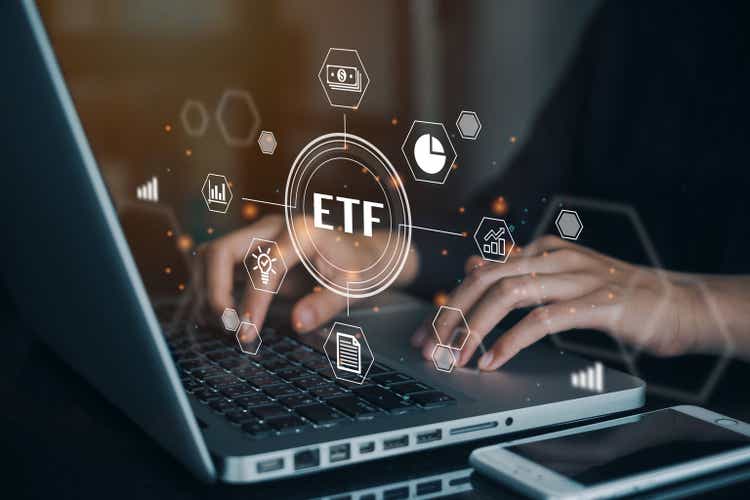[ad_1]
Khaosai Wongnatthakan
By David Mann, Head of Global Exchange Traded Funds Product and Capital Markets
In the midst of back-to-school season, David Mann opines on the real-life applications of mysterious middle-school math and exchange-traded funds.
In the last edition of this newsletter, I discussed getting into back-to-school mode with my kids. One month later, with both kids enjoying middle school, I find myself needing to up my game to ensure I can still answer all their math-related homework questions. Quick tangent: the way math is taught these days is way different than it was back when I was in middle school and yes, I did walk to school uphill both ways in the snow. My daughter was recently plowing through fractions and ratios without too much resistance. But toward the end, started complaining aloud that there was no point to this lesson as she would never use them in her life. As soon as the words left her mouth, I think she realized she had made a terrible mistake.
My kids should know better than to question the usage of mathematics, especially in front of their father, who also happens to author a bestselling ETF Capital Markets newsletter. I then had to decide which example of ETF industry ratios I should highlight for her. Given my recent call to have some better statistics within the ETF industry, I think the timing was perfect to revisit the ratio of an ETFs secondary market (exchange) volume-to-gross primary market (create/redeem) activity.
The early days of an ETF
Why should an investor care about this ratio? For starters, it’s a decent gauge of how much ETF trading reaches the underlying markets. In the early days of an ETF, I would expect this ratio to be close to one, as there are no existing shareholders who can sell shares to new investors. Likewise, there may not be any buyers in case one of the early shareholders wants to sell. As a result, ETF market makers must create (or redeem) shares to match any on-exchange demand. New ETFs will often see this ratio in the 1 to 2 range.
Investor adoption increases
As time passes, more trading occurs between new investors and existing shareholders without the involvement of ETF market makers, or similarly ETF market makers are actively buying and selling shares throughout the day. ETF volumes start increasing and typically bid/ask spreads start decreasing. There is now a greater likelihood that investors can transact on exchange without the need for ETF market makers trading the ETF’s underlying securities. ETFs that fit into this category usually see ratios in the 3 to 8 range—something we’ve recently seen in our largest single-country passive ETFs.
A different animal
Most funds will land in one of the two groups I just mentioned. Every so often, however, an ETF will take one more leap into a group that merits its own classification. These ETFs will typically have ratios over 50, which represents tons of on-exchange volume (sometimes in the billions) with very little create/redeem activity. I’ve had healthy debates with ETF industry friends over whether this is the preferred ratio group. On the one hand, there is no arguing that these ETFs have awesome counting stats—they are often multibillion-dollar funds with millions of shares traded daily.
However, I would argue there is a downside to all this volume with so little primary market activity. The concept of ETF arbitrage is that if the price of the ETF diverges from the price of the underlying basket, then ETF market makers will sell (or buy) the ETF and then simultaneously buy (or sell) the underlying basket as part of a creation (or redemption). If there are not any creations or redemptions, then the ETF would potentially trade more like a closed-end fund and experience greater premiums and discounts, especially during heightened market volatility. This is a concept that I discussed in March 2020 when even the highest volume of ETFs experienced excessive discounts to net asset value (NAV).
I am thus very excited to see more of our ETFs joining that second group. Of course, not nearly as excited as using ETFs to give my daughter real-life applications of what she is learning in school. Yes, she left the room 20 minutes ago.
What Are The Risks?
All investments involve risks, including possible loss of principal. The value of investments can go down as well as up, and investors may not get back the full amount invested. Generally, those offering potential for higher returns are accompanied by a higher degree of risk.
For actively managed ETFs, there is no guarantee that the manager’s investment decisions will produce the desired results.
ETFs trade like stocks, fluctuate in market value and may trade above or below the ETF’s net asset value. Brokerage commissions and ETF expenses will reduce returns. ETF shares may be bought or sold throughout the day at their market price on the exchange on which they are listed. However, there can be no guarantee that an active trading market for ETF shares will be developed or maintained or that their listing will continue or remain unchanged. While the shares of ETFs are tradable on secondary markets, they may not readily trade in all market conditions and may trade at significant discounts in periods of market stress.
Editor’s Note: The summary bullets for this article were chosen by Seeking Alpha editors.
[ad_2]
Image and article originally from seekingalpha.com. Read the original article here.

